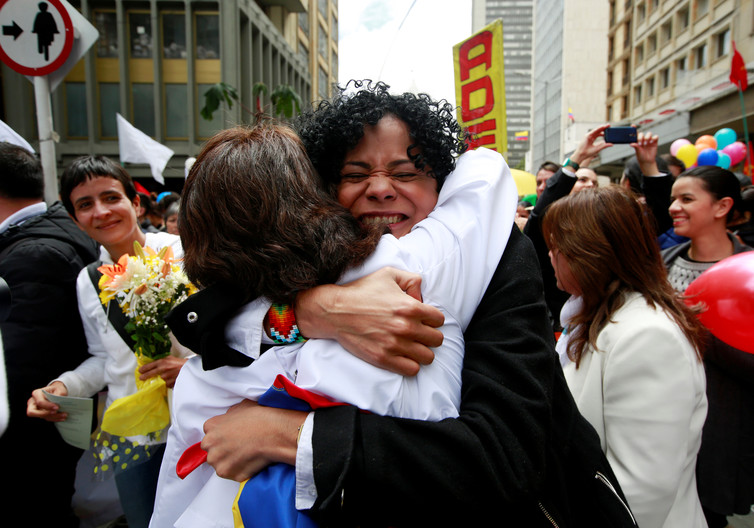
On September 26 2016, the Colombian government and the FARC guerrilla fighters put an end to half a century of confrontation, violence, and death, by signing a six-point peace agenda that was negotiated over nearly two years. The agreement, which will be put to voters in a plebiscite on October 2, is an opportunity to forge a new reality for Colombia’s war-wearied citizens.
Challenges ahead
The finalisation August 24 of the accords and their September 26 signing were not the end of the process for Colombia. The road to peace is long.
First, the country must vote to ratify the agreements on October 2, a simple “si” or “no” vote. The government and numerous civil society organisations such as Dejusticia, the Colombian Jurists Commission, and the Washington Office on Latin America have mobilised to increase public support for the agreements, and the polling is trending in that direction, but ratification is not assured.
In the immediate term, Colombians must accept transitional, restorative justice. Reconciliation is not easy; it doesn’t depend on logic or convincing other people that you’re right, but on emotions – often very private ones. Grief for the dead will almost always overwhelm rationality.
The FARC’s laying down of arms is only the beginning: its members, who have largely been isolated in rural and jungle settings in a Marxist society of their own making, must learn to live civic life and insert themselves gradually into the political and urban day-to-day rhythm of modern Colombia.
On the other side of the conflict are Colombia’s armed forces. They have battled the FARC for decades and they, too, must be deactivated, a no less complicated proposition. Their autonomy and centrality will decrease, and the possibility of criminal sanctions for abuses and repression hang above their heads.
The effectiveness of two key restorative justice bodies – the Commission for Clarifying Truth, Community, and Non-Repetition; and the Special Jurisdiction for Peace – also remain to be seen. The successful implementation of the accords and the permanence of a total guerrilla ceasefire will present significant challenges.
A model negotiation
Colombia’s negotiation, driven by President Juan Manuel Santos, is a model for conflict resolution at the global level.
First, Santos brought in respected mediators who had global credibility, including Dag Nylander of Norway. The talks were held in Cuba, a country that prides itself on political independence, with Chile and Venezuela observing.
Crucially, for the first time in the history of such peace discussions, victims had a seat at the negotiating table.
Each party had advisers who weren’t part of their group, and national citizen forums were held in different places, from the National University of Colombia or in churches, in events where victims could voice their feelings and ideas.
Finally, and crucially, Colombia has opted for restorative justice, not retaliation. The signed agreement proposes community service as a way to atone for damages done, rather than just throwing perpetrators of crimes in jail. This decision demonstrates the intent of both sides to reintegrate their armed combatants into society. Unlike other famous peace negotiations in the region – for example Salvador, where the United Nations played a key role in defining the conditions for peace – no external criteria were imposed.
The accords also include provisions for collective rights for Afro-Colombians, drug policy reforms and sustainable rural development.

Echoes across the continent
Colombia’s pending peace has great significance for the whole continent. The process is a rebuttal to the repressive military solution other South American nations (and Colombia itself) have historically launched to fight insurgencies or organised crime, for example in Peru, Mexico and Brazil.
The high level of regional support for the peace process was demonstrated by the presence of multiple Latin American leaders at the recent signing.
Colombia is demonstrating to Latin America – and to the world – that social and economic inequities cannot be resolved through violence, and that ideological differences are not a barrier to political negotiation.
A global effort
Colombia has dared to undertake that incredibly risky act: negotiating with terrorists. Throughout the peace talks, the Colombian government used creative diplomacy in pursuit of an agreement. Colombia secured regional and international buy-in, but still manage to maintain its own authority in the process, despite significant domestic partisan divide on the issue.
The United Nations, UNASUR (a regional governance body), international NGOs, and civil society associations such as the Latin American Continental and Caribbean Students and the Democratic Federation of Women will all help monitor and implement the accords.
This solidarity isn’t just about countries in the region showing support for a neighbour. Rather, it means concrete assistance with the implementation of the accords and with handling the daily tensions that can and will arise along the way.
The diplomacy and transparency with which these negotiations were conducted merits the respect of Colombian society and international observers. Colombia is entering an era of pain and sacrifice. It’s making a big wager: that hope is greater than death, and that even an imperfect peace trumps perpetual war.![]()
Rut Diamint, Profesora, Torcuato di Tella University
This article was originally published on The Conversation. Read the original article.

